White House
From Wikipedia, the free encyclopedia
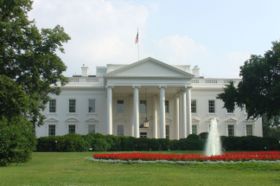 North façade of the White House, seen from Pennsylvania Avenue.
A visiting head of state enters the house for a state dinner through
the North Portico. Tourists finish their tour by exiting through the
North Portico. The house was originally built without porticos. Before
construction of the north portico in 1824, the north façade looked much
more similar to Leinster House .
Both James Hoban–original architect of the White House, and Benjamin
Henry Latrobe who developed plans for its rebuilding after the 1814
fire, proposed north and south porticos. Both porticos, as built, are
the work of Hoban.
North façade of the White House, seen from Pennsylvania Avenue.
A visiting head of state enters the house for a state dinner through
the North Portico. Tourists finish their tour by exiting through the
North Portico. The house was originally built without porticos. Before
construction of the north portico in 1824, the north façade looked much
more similar to Leinster House .
Both James Hoban–original architect of the White House, and Benjamin
Henry Latrobe who developed plans for its rebuilding after the 1814
fire, proposed north and south porticos. Both porticos, as built, are
the work of Hoban.The White House is the official home and principal workplace of the President of the United States of America. The house is built of white-painted Aquia sandstone in the late Georgian style. It is located at 1600 Pennsylvania Avenue in Washington, D.C. As the office of the U.S. President, the term "White House" is used as a metonym for a U.S. president's administration. The property is owned by the National Park Service and is part of "President's Park."
History
Architectural competition
The young republic's new capital city was sited on land ceded by two states—Virginia and Maryland—which both transferred ownership of the land to the federal government in response to a compromise with President Washington. The D.C. commissioners were charged by Congress with building the new city under the direction of the President. The architect of the White House was chosen in a competition, which received nine proposals. President Washington traveled to the site of the new federal city on July 16, 1792 to make his judgment. His review is recorded as being brief and he quickly selected the submission of James Hoban, an Irishman living in Charleston, South Carolina. The briefness of Washington's review of the plans may have been due to the majority of the submissions being awkward and naïve. Washington was not entirely pleased with the original Hoban submission. He found it too small, lacking ornament, and not fitting the nation's president. On Washington's recommendation the house was enlarged by thirty percent, a large reception hall, the present East Room, was added. This was likely inspired by the large reception room at Mount Vernon.
Construction
Construction began with the laying of the cornerstone on
October 13,
1792.
A diary kept by the District of Columbia building
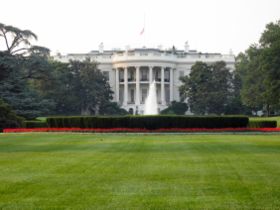 commissioner records
that the footings for the main residence were dug by slaves. The
foundations were also built by slave labor. Much of the other work on
the house was performed by immigrants, many not yet with citizenship.
The sandstone walls were erected by Scottish immigrants, as were the
high relief rose and garland decorations above the north entrance and
the "fish scale" pattern beneath the pediments of the window hoods.
Much of the brick and plaster work was produced by Irish and Italian
immigrants. The initial construction took place over a period of eight
years, at a reported cost of $232,371.83 ($2.4 million in 2005
dollars). Although not yet completed, the White House was ready for
occupancy on or about
November 1,
1800.[1]
When construction was finished the porous sandstone walls were coated
with a mixture of lime, rice glue, casein, and lead, giving the house
its familiar color and name.
commissioner records
that the footings for the main residence were dug by slaves. The
foundations were also built by slave labor. Much of the other work on
the house was performed by immigrants, many not yet with citizenship.
The sandstone walls were erected by Scottish immigrants, as were the
high relief rose and garland decorations above the north entrance and
the "fish scale" pattern beneath the pediments of the window hoods.
Much of the brick and plaster work was produced by Irish and Italian
immigrants. The initial construction took place over a period of eight
years, at a reported cost of $232,371.83 ($2.4 million in 2005
dollars). Although not yet completed, the White House was ready for
occupancy on or about
November 1,
1800.[1]
When construction was finished the porous sandstone walls were coated
with a mixture of lime, rice glue, casein, and lead, giving the house
its familiar color and name.
Evolution of the White House
John Adams became the first president to take residence in the building on November 1, 1800. During Adams' second day in the house he wrote a letter to his wife Abigail, containing a prayer for the house. Adams wrote:
| “ | I pray Heaven to bestow the best of blessings on this House, and all that shall hereafter inhabit it. May none but honest and wise men ever rule under this roof. | ” |
Franklin Delano Roosevelt had Adams' blessing carved into the mantel in the State Dining Room.
Adams lived in the house only briefly, and the home was soon occupied by
Thomas Jefferson who gave consideration to how the White House might be added to. With
Benjamin Henry Latrobe,
he helped lay out the design for the East and West
Colonnades, small
wings that help conceal the domestic operations of laundry, a stable
and storage. Today Jefferson's colonnades link the residence with the
East and West Wings.
During the War of 1812 much of Washington was burned by British troops in retaliation for burning Upper Canada's Parliament Buildings in the Battle of York (present day Toronto) leaving the White House gutted. Only the exterior walls remained, and they had to be torn down and mostly reconstructed due to weakening from the fire and subsequent exposure to the elements, except for portions of the south wall. A legend emerged that during the rebuilding of the structure white paint was applied to mask the burn damage it had suffered, giving the building its namesake hue. This is unfounded as the building had been painted white since its construction in 1798. Of the numerous spoils taken from the White House when it was ransacked by British troops, only two have been recovered — a painting of George Washington, rescued by then-first lady Dolley Madison, and a jewelry box returned to President Franklin Delano Roosevelt in 1939 by a Canadian man who said his grandfather had taken it from Washington. Most of the spoils were lost when a convoy of British ships led by HMS Fantome sank en route to Halifax off Prospect during a storm on the night of 24 November 1814. [2]
After the fire, both Latrobe and Hoban contributed to the design and oversight of the reconstruction. The north portico was built in 1824, and though architect Benjamin Henry Latrobe proposed similar porticos during the rebuilding after the fire in 1814, both porticos were designed by Hoban. Contrary to a frequently published myth, the North Portico was not modeled on a similar portico on another Dublin building, the Viceregal Lodge (now Áras an Uachtaráin, residence of the President of Ireland). Its portico in fact postdates the White House porticos' design. The South portico was built in 1829. The similarity between the South Portico, and an elliptical portico, with nearly identical curved stairs at Château de Rastignac in Périgord, France is frequently speculated as the source. The decorative stonework on both porticos were carved by Italian artisans brought to Washington to help in constructing the U.S. Capitol. For the North Portico, a variation on the Ionic Order was devised incorporating a swag of roses between the volutes. This was done to link the new portico with the earlier carved roses above the entrance.
Overcrowding and the West Wing
By the time of the American Civil War, the White House was overcrowded. Some also complained about the location of the White House, just north of a canal and swampy lands, which provided conditions ripe for malaria and other unhealthy conditions.[1] Brigadier General Nathaniel Michler was tasked to propose solutions to address these concerns.[1] He proposed to abandon the White House as a residence, and use it only for business; He proposed a new estate for the first family at Meridian Hill in Washington, D.C.[1] This plan was rejected by Congress.
In 1891, First Lady Caroline Harrison proposed extensions to the White House, including a National Wing on the east for a historical art gallery, and a wing on the west for official functions.[1] A plan was devised by Colonel Theodore A. Bingham, which reflected the Harrison Plan.[1] In 1901, Theodore Roosevelt and his large family moved in to the White House and found the overcrowding unbearable.[1] McKim, Mead, and White was hired to carry out renovations and expansion, including the West Wing. The first family spent four months of 1902 in a temporary home at 22 Jackson Place.[1] By 1909, more space was needed by President William Taft. Architect Nathan C. Wyeth was hired to add space to the West Wing, which included the addition of the Oval Office.[1]
The Truman reconstruction
Decades of poor maintenance and the construction of a fourth story attic during the Coolidge administration took a great toll on the brick and sandstone structure built around a timber frame. By 1948 the house had became so unsound that President Truman abandoned it, moving across the street to Blair House, from 1949-1951. The reconstruction, done by the firm of Philadelphia contractor John McShain, required the complete dismantling of the interior spaces, construction of a new load bearing internal steel frame and the reconstruction of the original rooms within the new structure. Some modifications to the floor plan were made, the largest being the repositioning of the grand staircase to open into the Entrance Hall, rather than the Cross Hall. Central air conditioning was added, and two additional sub-basements providing space for workrooms, storage and a Cold War era bomb shelter. The Trumans moved back into the White House on March 27, 1952. While the house was saved by the Truman reconstruction, much of the new interior finishes were generic, and of little historic value. Much of the original plasterwork, some dating to the 1814-1816 rebuilding was too damaged to reinstall, as was the original robust Beaux Arts paneling in the East Room. President Truman had the original timber frame sawed into paneling. The walls of the Vermeil Room, Library, China Room, and Map Room on the ground floor of the main residence were paneled in wood from the timbers.
The Kennedy restoration
Jacqueline Kennedy, wife of President
John F. Kennedy (1961–63), directed the most extensive and historic redecoration of the house in its history.
Henry Francis du Pont of the
Winterthur Museum
chaired a White House Fine Arts Committee. Research was conducted on
the use and decoration of the house's primary rooms. Different periods
of the early republic were selected as a theme for each room: the
Federal style for the
Green Room; French Empire for the
Blue Room; American
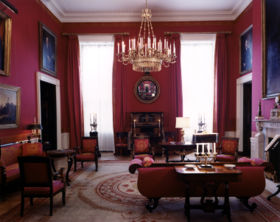 Empire for the
Red Room; Louis XVI for the
Yellow Oval Room;
and Victorian for the president's study, renamed the Treaty Room.
Antique furniture was acquired, and decorative fabric and trim based on
period documents was produced and installed. Many of the antiques, fine
paintings, and other improvements of the Kennedy period were donated to
the White House by wealthy donors, including the Crowninshield family,
Jane Engelhard, Jayne Wrightsman, and the
Oppenheimer
family. The Kennedy restoration resulted in a White House that was
almost regal in feeling, and which recalled the French taste of Madison
and Monroe. Much of the French taste originated with the interior
decorator
Stéphane Boudin of the
House of Jansen, a Paris interior-design firm that had designed interiors for Elsie de Wolfe, Lady Olive Baillie, the royal families of
Belgium and
Iran, the German
Reichsbank during the period of
National Socialism, and
Leeds Castle
in Kent. The first White House guide book was produced under the
direction of curator Lorraine Waxman Pearce with direct supervision
from Jacqueline Kennedy. Sale of the guide book helped finance the
restoration.
Empire for the
Red Room; Louis XVI for the
Yellow Oval Room;
and Victorian for the president's study, renamed the Treaty Room.
Antique furniture was acquired, and decorative fabric and trim based on
period documents was produced and installed. Many of the antiques, fine
paintings, and other improvements of the Kennedy period were donated to
the White House by wealthy donors, including the Crowninshield family,
Jane Engelhard, Jayne Wrightsman, and the
Oppenheimer
family. The Kennedy restoration resulted in a White House that was
almost regal in feeling, and which recalled the French taste of Madison
and Monroe. Much of the French taste originated with the interior
decorator
Stéphane Boudin of the
House of Jansen, a Paris interior-design firm that had designed interiors for Elsie de Wolfe, Lady Olive Baillie, the royal families of
Belgium and
Iran, the German
Reichsbank during the period of
National Socialism, and
Leeds Castle
in Kent. The first White House guide book was produced under the
direction of curator Lorraine Waxman Pearce with direct supervision
from Jacqueline Kennedy. Sale of the guide book helped finance the
restoration.
Establishment of the Committee for the Preservation of the White House
The Kennedys' Fine Arts Committee eventually became the
congressionally authorized Committee for the Preservation of the White
House, whose mission is to maintain the historical integrity of the
White House. The committee works with the First Family, usually
represented by the First Lady, the White House Curator, the Chief Usher
of the White House, and the White
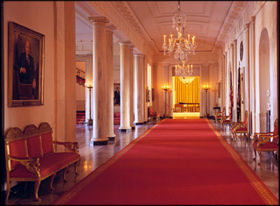 House Curator of Fine Arts. Since the
committee's establishment, every presidential family has made some
changes to the family quarters of the White House, but changes to the
State Rooms must all be approved by the Committee for the Preservation
of the White House. During the Nixon administration, First Lady Pat
Nixon refurbished the Green Room, Blue Room and Red Room, working with
Clement Conger, the curator they appointed. In the 1990s President and
Mrs. Clinton had some of the rooms refurbished by Arkansas decorator
Kaki Hockersmith. During the Clinton administration the East Room, Blue
Room, State Dining Room and Lincoln Sitting Room were refurbished. A
recent refurbishment of the Lincoln Bedroom begun during the Clinton
administration was completed in President George W. Bush's
administration, and the refurbishment of the Green Room and East Room
has begun. The White House is one of the first government buildings in
Washington that was made wheelchair-accessible, with modifications
having been made during the presidency of
Franklin D. Roosevelt, who needed to use a wheelchair as a result of his
polio. In the 1990s
Hillary Rodham Clinton,
at the suggestion of Visitors Office Director Melinda N. Bates,
approved the addition of a ramp in the East Wing corridor. It allowed
easy wheelchair access for the public tours and special events that
enter through the secure entrance building on the east side.
House Curator of Fine Arts. Since the
committee's establishment, every presidential family has made some
changes to the family quarters of the White House, but changes to the
State Rooms must all be approved by the Committee for the Preservation
of the White House. During the Nixon administration, First Lady Pat
Nixon refurbished the Green Room, Blue Room and Red Room, working with
Clement Conger, the curator they appointed. In the 1990s President and
Mrs. Clinton had some of the rooms refurbished by Arkansas decorator
Kaki Hockersmith. During the Clinton administration the East Room, Blue
Room, State Dining Room and Lincoln Sitting Room were refurbished. A
recent refurbishment of the Lincoln Bedroom begun during the Clinton
administration was completed in President George W. Bush's
administration, and the refurbishment of the Green Room and East Room
has begun. The White House is one of the first government buildings in
Washington that was made wheelchair-accessible, with modifications
having been made during the presidency of
Franklin D. Roosevelt, who needed to use a wheelchair as a result of his
polio. In the 1990s
Hillary Rodham Clinton,
at the suggestion of Visitors Office Director Melinda N. Bates,
approved the addition of a ramp in the East Wing corridor. It allowed
easy wheelchair access for the public tours and special events that
enter through the secure entrance building on the east side.
Layout and facts
Today the small group of buildings housing the presidency is known as the White House Complex. It includes the central Executive Residence flanked by the East Wing and West Wing. Day to day household operations are coördinated by the Chief Usher. Few people realize the size of the White House, since much of it is below ground or otherwise minimized by landscaping. The White House includes: 6 stories and 55,000 ft² (5,100 m²) of floor space, 132 rooms and 35 bathrooms [3], 412 doors, 147 windows, 8 fireplaces, 8 staircases, 3 elevators, 5 full-time chefs, 5,000 visitors a day, a tennis court, bowling alley, movie theater, jogging track, swimming pool, and putting green.
The West Wing houses the President's office (the Oval Office) and offices of his senior staff, with room for about 50 employees. It also includes the Cabinet Room, where the United States Cabinet meets, and the White House Situation Room. Some members of the President's staff are located in the adjacent Old Executive Office Building in the former State War and Navy building, sometimes known as the Eisenhower Executive Office Building.
This portion of the building was used as the setting for the popular television show The West Wing.
The East Wing
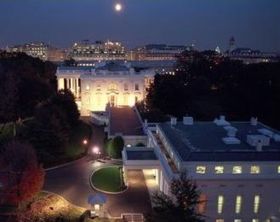 The East Wing, which contains additional office space, was added to
the White House in 1942. Among its uses, the East Wing has
intermittently housed the offices and staff of the
First Lady,
and the White House Social Office. Rosalynn Carter, in 1977, was the
first to place her personal office in the East Wing and to formally
call it the "Office of the First Lady." The East Wing was built during
World War II
in order to hide the construction of an underground bunker to be used
in emergency situations. The bunker has come to be known as the
Presidential Emergency Operations Center.
The East Wing, which contains additional office space, was added to
the White House in 1942. Among its uses, the East Wing has
intermittently housed the offices and staff of the
First Lady,
and the White House Social Office. Rosalynn Carter, in 1977, was the
first to place her personal office in the East Wing and to formally
call it the "Office of the First Lady." The East Wing was built during
World War II
in order to hide the construction of an underground bunker to be used
in emergency situations. The bunker has come to be known as the
Presidential Emergency Operations Center.
The White House grounds
Before the construction of the North Portico most public events were
entered from the South Lawn, which was graded and planted by Thomas
Jefferson. Jefferson also drafted a planting plan for the North lawn
that included large trees that would have mostly obscured the house
from Pennsylvania Avenue. During the mid to late nineteenth century a
series of ever larger green
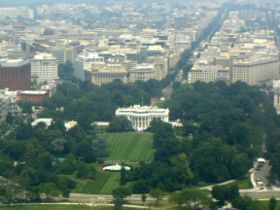 houses were built on the west side of the
house, where the current West Wing is located. During this period the
North lawn was planted with ornate "carpet style" flower beds. Although
the White House grounds have had many gardeners through their history,
the general design, still largely used as master plan today, was
designed in 1935 by
Frederick Law Olmsted, Jr. of the
Olmsted Brothers firm, under commission from President Franklin D. Roosevelt. During the Kennedy administration the
White House Rose Garden was redesigned by Rachel Lambert Mellon. On the weekend of June 23, 2006, a century-old
elm tree on the north side of the building, came down during one of the many storms of the
Mid-Atlantic Flood of June 2006. This elm is depicted on the right side on the back of the
$20 bill.
This tree was believed to have been planted between 1902 and 1906
during Theodore Roosevelt's administration. Among the oldest trees on
the grounds are several magnolias (Magnolia grandiflora) planted by Andrew Jackson.
houses were built on the west side of the
house, where the current West Wing is located. During this period the
North lawn was planted with ornate "carpet style" flower beds. Although
the White House grounds have had many gardeners through their history,
the general design, still largely used as master plan today, was
designed in 1935 by
Frederick Law Olmsted, Jr. of the
Olmsted Brothers firm, under commission from President Franklin D. Roosevelt. During the Kennedy administration the
White House Rose Garden was redesigned by Rachel Lambert Mellon. On the weekend of June 23, 2006, a century-old
elm tree on the north side of the building, came down during one of the many storms of the
Mid-Atlantic Flood of June 2006. This elm is depicted on the right side on the back of the
$20 bill.
This tree was believed to have been planted between 1902 and 1906
during Theodore Roosevelt's administration. Among the oldest trees on
the grounds are several magnolias (Magnolia grandiflora) planted by Andrew Jackson.